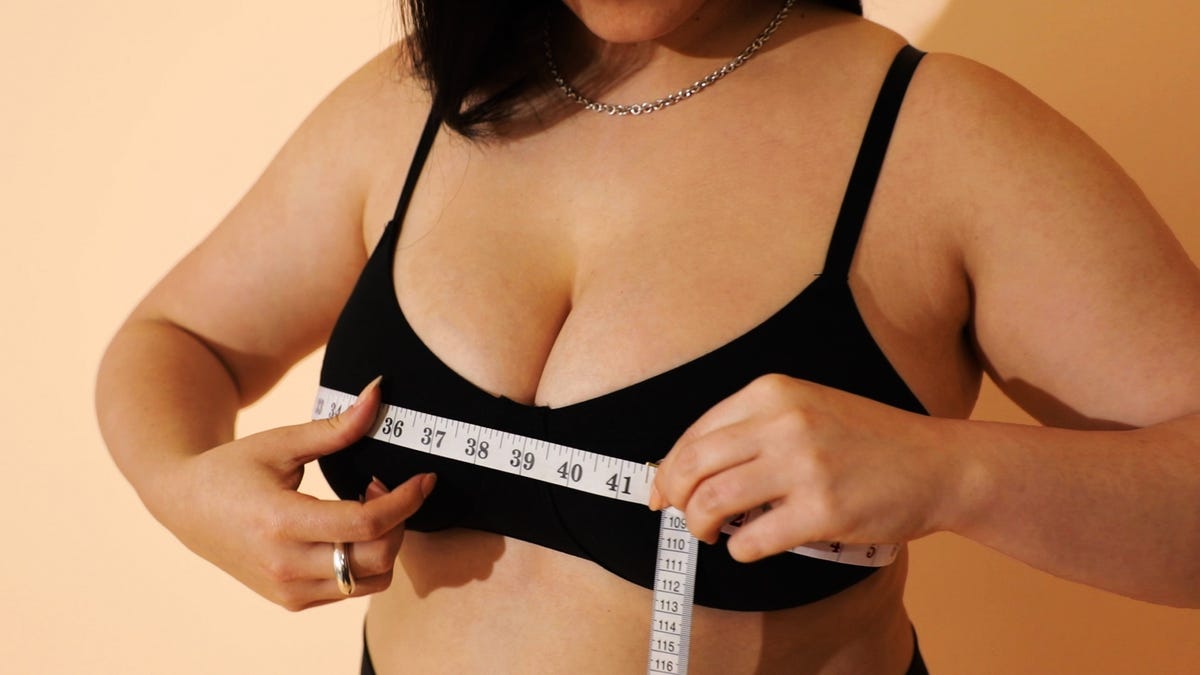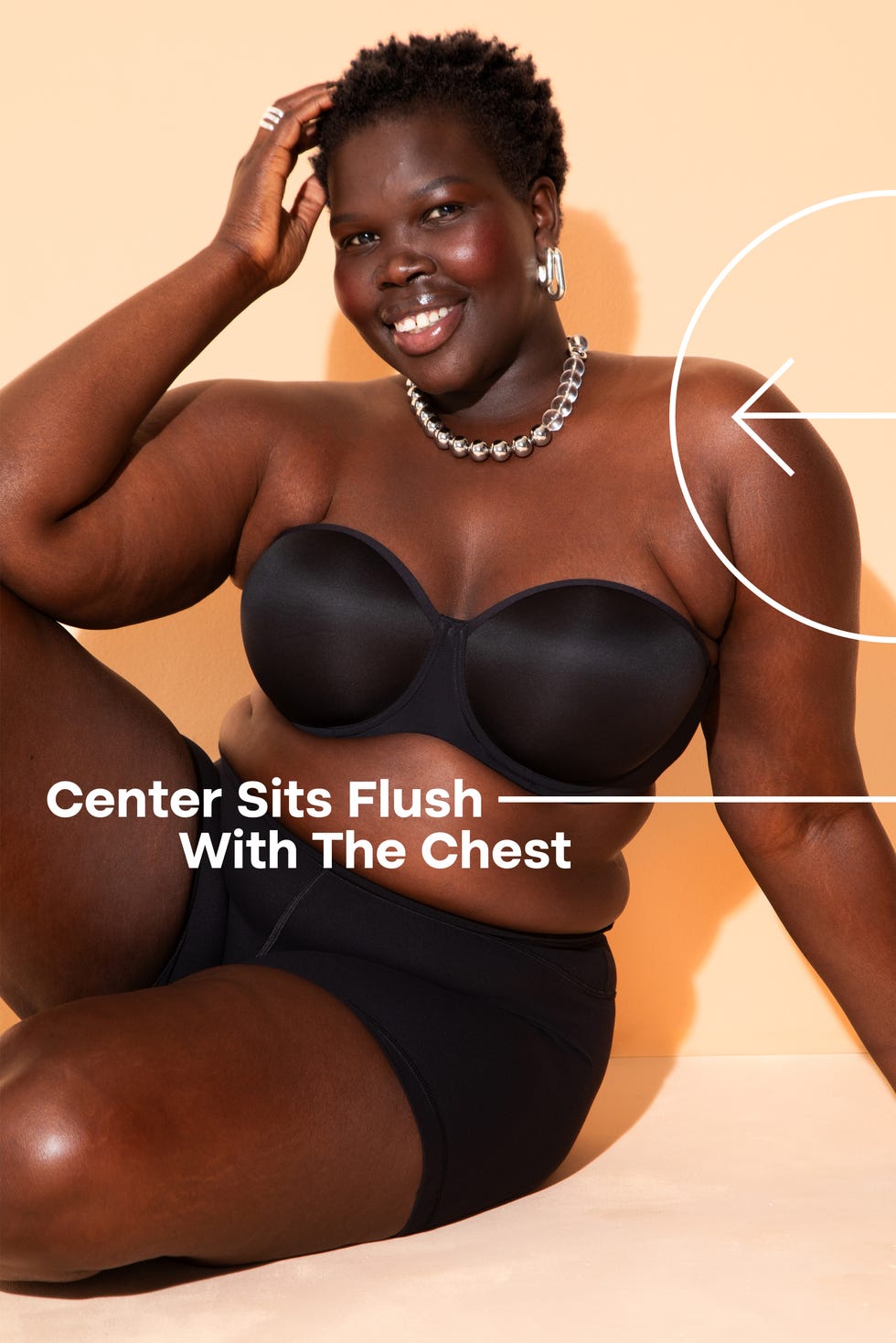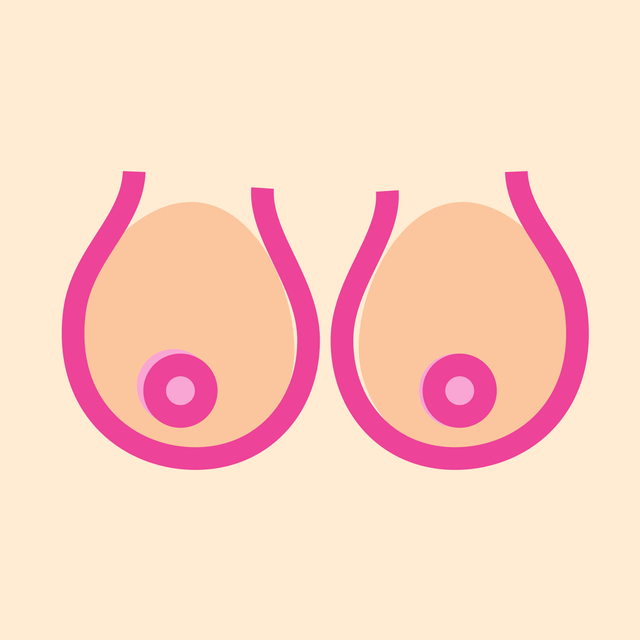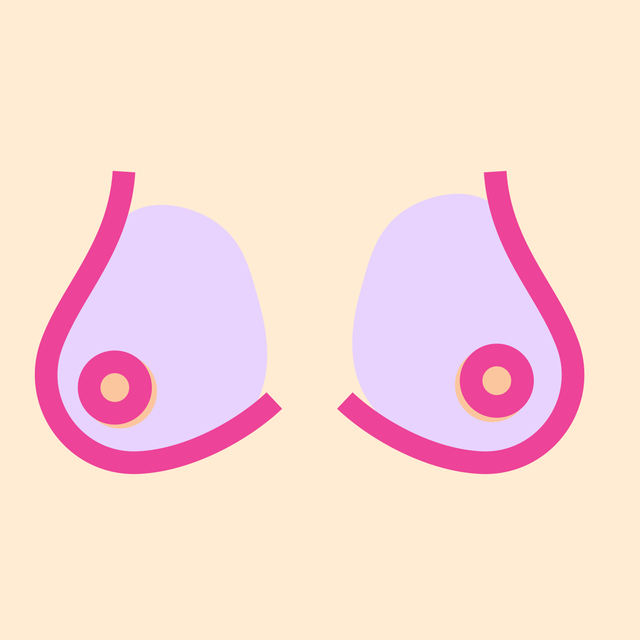Scoring the perfect pair of everyday jeans or a dress you can’t wait to dance the night away in? That’s the kind of shopping that feels like a special treat. But buying a new bra? You probably dread the day you need to add something, anything to your undergarments collection.
It’s not your fault, experts say. Frankly, the intimates industry has made it nearly impossible to enjoy the experience, let alone find a decent fit, because bras are undeniably technical garments. No two breasts are the same—not even the two sitting next to one another on the same person. Shapes vary, volumes are not equal, and those variables can change—a lot—from year to year and even month to month, depending on life events like pregnancy, weight fluctuations, lifestyle changes, or illness.
When shopping for a bra, the number one problem women face is the lack of sizes carried in stores, says Laura Burke, intimate apparel stylist, certified bra fit expert, and founder of Fit by Burke in Larchmont, New York. Most stores usually carry around 40 “standard sizes,” which are a combination of band sizes 32–38 and cup sizes B–D, she explains. The problem? “Today, there are actually closer to 200 sizes available, running all the way up to an N cup,” says Burke.
And even when you visit a certified bra fit expert and zero in on your “true” size, you can’t just pluck that size off the rack and call it a day. “No manufacturer cuts their bras the same way,” says Helene T. Delince, founder of The Fitting Curve in Rockville Center, New York. “Even within the same brand, one style might fit and the other might not.” Fabrics, wire, and general style can all affect the fit, and ultimately, the size of the bra.
Bra shopping is so complicated, in fact, that only a small percentage of shoppers walk out of the store with their true size, says Burke.
And, unfortunately, when you’re not wearing the right bra size, it can not only affect how your clothes look and fit, but can also lead to a lot of discomfort—particularly for women with large busts. “[Wearing the wrong size] can actually lead to headaches, back pain, and overall posture problems,” says Laura Henny, owner of The Rack Shack in Brooklyn, New York.
This is particularly an issue if your bra is too tight, as that can restrict the movement of your ribcage and chest, leading to back discomfort or posture issues down the road, says Winnie Yu, PT, DPT, CSCS, a physical therapist at Bespoke Physical Therapy in New York. “A compromised ability of the thorax to expand can also lead to less airflow with each breath,” she adds. “Over time, if you are limiting the natural airflow with each breath, you may be depriving the brain of oxygen and experience headaches when wearing the bra.” What’s more: If the chest cannot expand properly, you will begin to use your accessory muscles, a.k.a. those in the upper chest and neck, to breathe. This overcompensation can lead to muscular imbalances, as well as neck and upper back issues, says Yu, which, over time, can be linked with headaches and even migraines.
To help you avoid this—sometimes quite literal—headache, Women’s Health tapped four bra experts to identify common bra fit issues and explain how to effectively measure your bra size, whether you’re shopping for an everyday T-shirt bra, a bralette for lounging, a sports bra for impact, or a strapless or backless bra for your slinkiest dress.
All of these issues point to some type of fit problem. Spillage, for example, typically means the cup is too small, while gaping tends to point to a bra that’s too large, says Henny.
The best solution, according to all four bra fit experts, is to visit a professional fitter who is trained to not only give you the most accurate bust measurements, but also has a wealth of knowledge about bra shapes and types. That said, not everyone has the means or access to a pro bra fitter, which is why it’s also a good idea to measure your bra size at home.
How to Measure Your Bra Size at Home
1. Determine your bra band size.
Using a tailor’s measuring tape—the soft, malleable kind—measure the circumference of your body around your ribcage directly underneath your breast fold, or where your breast is attached to your body, says Henny. The tape should be level and snug against your body. The number in inches correlates to your band size. If you’re in between standard band sizes, which are all even numbers, round up. For example, if you measure 33 inches, round up to the nearest size: 34 inches. Even if you’re just over—let’s say you measure 32.5 inches, it’s still wise to round up to 34, says Henny.
2. Measure your bust.
Next, while wearing your best-fitting unpadded bra, measure yourself at the fullest part of your bust (typically in line with the nipples). This time the tape shouldn’t be so snug, but rather glide right over the breast tissue. Record the number in inches to the nearest round number. So if you measure a 38.5, you’d record 39.
3. Calculate your cup size.
Here’s where the math comes in. In order to determine your cup size, you have to find the difference between your band size and bust size. For example, if your band size is a 34, but your bust is measuring a 38, there’s a 4 point difference: A is 1, B is 2, C is 3, and D is 4. So, in this case, your cup size is a D. When you put the two together, you’ll get your overall size: 34D.
TIP: Don’t have a soft measuring tape available? Here’s a simple hack from Henny. Wrap something long and malleable, like a piece of string or rope, around your ribcage and then your bust. Mark your measurements on the string and then measure it with a regular measuring tape or a ruler to get your measurements.
How to Measure Yourself for a Sports Bra
You’ve figured out your regular bra size, but what about a sports bra? It may feel like the stakes are lower here since they often come in sizes like small, medium, and large, rather than traditional band and cup sizes. However, just like other bras, a sports bra is a technical garment and it’s very hard to find the right fit, says Delince. She recommends following the above guidelines for measuring and purchasing a sports bra that follows traditional band and cup sizes. If you’re not buying a sports bra in traditional band and cup sizes, check your band and cup size against the brand’s size chart to find the best fit.
And remember that the exact size and amount of support you need may vary based on the physical activity, so you’ll likely need to stock up on more than one type of sports bra—much like how experts recommend having different types of everyday bras. Overall, lighter impact activities, like yoga, require less overall support; higher impact activities, like running or playing pickleball, will require a more compressive sports bra with more support in the back and bottom bands.
How to Measure Yourself for a Strapless Bra
Ah, the strapless bra. It’s considered “a basic item in a women’s wardrobe,” by bra fit experts, including Lori Kaplan, founder of BraTenders NYC, but strapless bras get a bad rap for being even more uncomfortable than regular bras. They slide down, they dig in—it seems like there’s always some sort of issue.
But here’s the thing: You don’t need to measure them differently than any other bra. “There’s a lot of misinformation telling women to go a band size smaller,” says Kaplan. Like all bras, it really comes down to trial and error based on your own breast shape, body type, and how your breasts are set on your body. You’ll want to look for signs of a good fit—no bulging or gaping, a center that sits flush with the chest, and wires in line with the arm pit, for example.
How to Measure Yourself for a Backless Bra
Backless styles are even trickier, says Kaplan, since they’re technically bustiers (a long-line bra that sits tight against the midriff and pushes up the breasts). “The fitting process is completely different,” she explains, noting backless styles essentially remove all support from a bra, since as much as 90 (!) percent of the support comes from a bra’s back band. (That’s like asking an architect to design a building without the main support beam.)
To find the best option for you, Kaplan strongly suggests visiting a bra fit boutique for a consultation with a fitter who specializes in backless bras—before you shop for the dress or top you’ll wear this bra under, if possible. If your search for a backless bra ends up being a bust (pun intended), adhesives and bra tapes are worthy alternatives, she says. “Today, there are some great products that can support girls up to an H cup.”
How to Make Sure Your Bra Size Is Correct
A handful of simple wear tests can help you determine if you’re wearing the correct bra size:
Do the swoop and scoop
First and foremost, make sure you’re wearing your bra the right way, says Kaplan. “When you put your bra on, bend forward a little bit and move all of the breast tissue away from your armpits, into the center of your body, and up into the cups.”
Make sure the band is level all the way around
If it’s riding up, that usually means the band is too loose, says Henny. This can transfer the weight of your breasts to the shoulders, ultimately leading to comfort issues.
Wear the band on the first set of hooks.
The band should fit relatively snug. “You should have about ½ inch to 1 inch of resistance in the band,” says Burke. Once the band starts to loosen, you can move to the second set of hooks and so on.
Check that any wires are in line with your armpit.
Your breast tissue starts under your armpit, so that’s where the cup should fit, says Kaplan. If the wires are poking you, the cup may not be big enough, says Delince.
Keep an eye out for any bulging or gaping.
Overflowing on the sides or in the front typically indicates the bra cups are too small, says Henny. Conversely, any extra room in the cups usually means they’re too big.
Adjust the straps.
Straps that continually fall down aren’t necessarily a fit issue—you may just have to adjust them, says Delince. However, some styles, like demi bras, have straps that naturally sit further out on the shoulders. If you fit for comfort and go with a bigger band size, it can impact how far the straps sit out on the shoulders, causing them to slide down.
Make sure the bridge of the bra is flush with the breast bone.
If the center of the bra doesn’t sit right up against the sternum, it could be a sign that the cups are too small. But it also might not be the best type of bra for your breast shape and body type, says Delince, who notes that people with concave chests or breasts that sit tightly together may find wireless bras fit better than underwire bras.
What Is the Best Type of Bra for My Breast Shape?
Breasts come in all shapes and sizes—and almost everyone’s will change over time. In fact, your breasts change between 6 to 10 times throughout your life, says Kaplan. Still, there are some common overarching categories that can help direct you to the right type of bra for your current breast shape:
Round
As the name suggests, these breasts are typically fuller all around. Since most styles generally work for this breast shape, consider plunge styles for a flattering fit and stretchy, wireless styles for comfort.
Asymmetric
This is exactly what it sounds like: two breasts that don’t necessarily match up in shape and size. And if this sounds like you, base your cup size on the larger breast. Our experts say plunge styles with removable inserts can help you achieve a more even look.
Bell-Shaped
Slimmer at the top and fuller at the bottom, bell-shaped breasts are more common in women with larger cup sizes. Because of this, full-coverage styles with wider straps may be most supportive. But regardless of bra style, be mindful of correct band size, says Delince, as most support comes from the band around the rib cage.
Wide-Set Breasts
Sometimes called East-West breasts, these breasts sit further apart and tend to have nipples that point to the sides. Look for styles that offer side support or light padding around sides of the wire to push breasts closer toward the center, per Delince.
Athletic
This shape is more prone to gaping than others, since athletic breasts have less tissue (i.e., are smaller) and are generally wider and more muscular. “For breast tissue that has a shallow projection, lightly lined or padded styles can help with lift and the look of a fuller bust if that is the goal,” says Delince. “A demi style with an underwire or wireless bralette works really with this breast shape.”
Bra Size Measurement FAQs
Meet the Experts: Laura Burke is an intimate apparel stylist, certified bra fit expert, and founder of Fit by Burke in Larchmont, New York. Helene T. Delince is founder of The Fitting Curve in Rockville Center, New York. Laura Henny is owner of The Rack Shack in Brooklyn, New York. Winnie Yu, PT, DPT, CSCS, is a physical therapist at Bespoke Physical Therapy in New York. Lori Kaplan is founder of BraTenders NYC.
Photographed by Eli Schmidt. Styled by Rose Lauture. HAIR: Anike Rabiu using Oribe. MAKEUP: Magdalena Major using Armani. MANICURE: Leanne Woodley for @she.nails.it @seemanagement.
Brigitt is a writer, editor and craft stylist with nearly 15 years of experience. She specializes in lifestyle topics, including home, health, parenting, beauty, style, food, entertaining, travel and weddings. She has written for Glamour, People, Good Housekeeping, Women’s Health, Real Simple, Martha Stewart, Apartment Therapy, The Spruce, and more.
Read the full article here

































